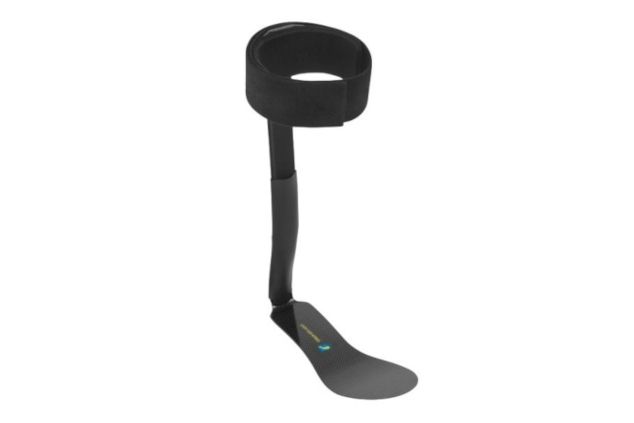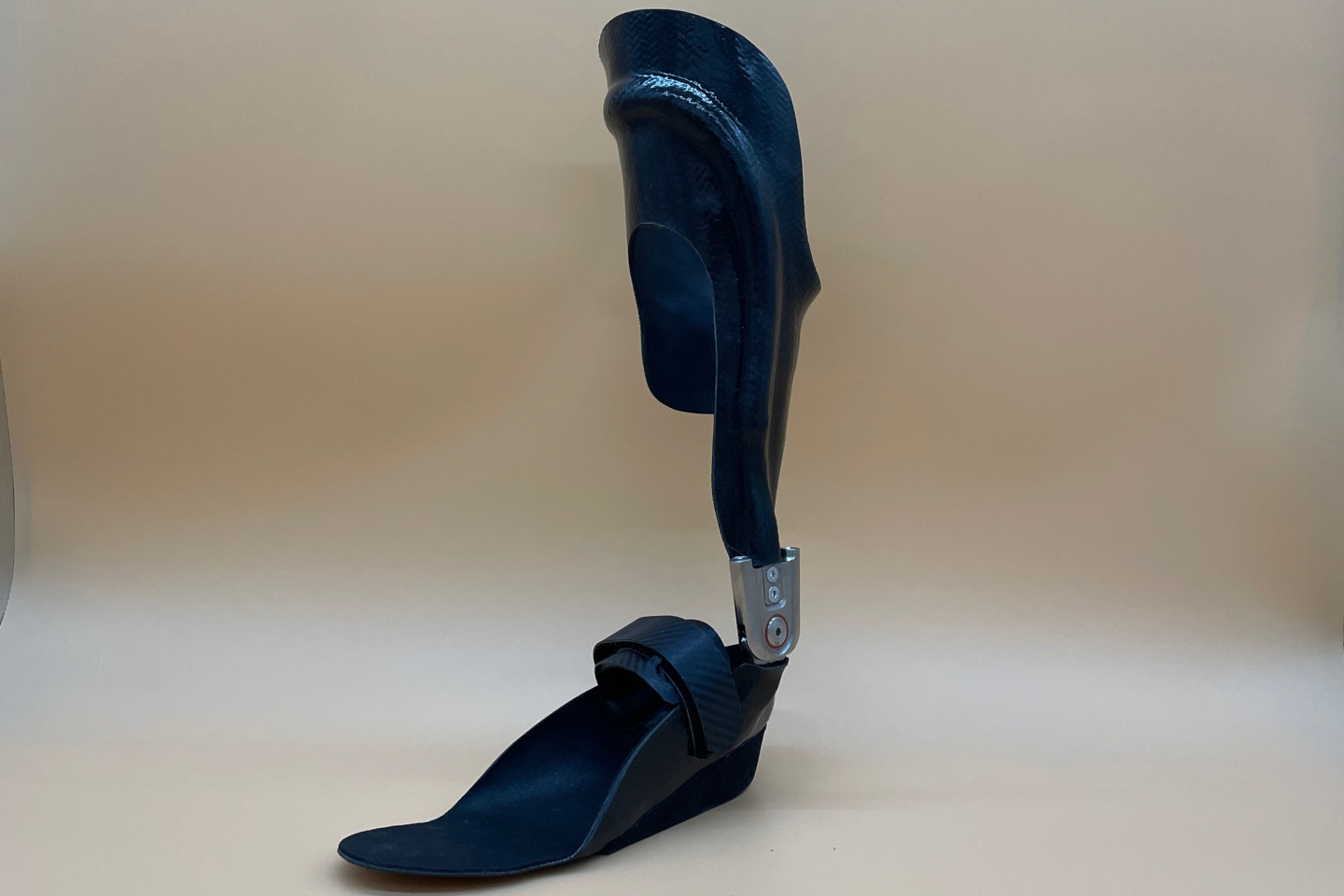Posterior Shell AFO
Posterior Shell AFOs covers the rear of the leg, the bottom of the foot and cross the ankle joint.
These AFOs are generally made from carbon fibre or plastic and can be prescribed in multiple types, which are listed below.
The shell of the posterior shell AFO refers to the part of the brace that is in contact with the leg.
Unlike other AFOs, posterior shell AFOs do not cover the front of the leg. Instead, they have straps that secure the leg into the brace.

What Conditions are Posterior Shell AFOs Considered For?
When deciding on trimlines, materials and ankle joint function for an AFO we take into consideration the physical presentation more than the patient’s diagnosis.
We mostly recommend posterior shell AFOs for people living with:
- Cerebral palsy
- Spina bifida
- Down syndrome
- Autism spectrum disorder
- Global developmental delay
- Idiopathic toe walking
They can also be prescribed for genetic, chromosomal, or connective tissue disorders and for children who have recently had foot, ankle, or lower-limb surgeries.

Why a Posterior Shell Over Other Types of AFOs?
The decision of which AFO to recommend is based on the amount of control that the patient needs over their limb, ankle, foot and knee.
Depending on what movement we want control or what deficit the patient has, we will vary the makeup of the AFO. For example, for someone with quadricep weakness, we would likely consider a ground-reaction AFO with an anterior shell (or a shell at the front of the shin) instead of a posterior shell AFO.
With paediatric patients, it can also be beneficial to use less material overall, leading us to recommend a posterior shell AFO. If it’s not necessary, then we won’t recommend adding anything at the front of the leg apart from the straps.

How a Posterior Shell AFO Works
Ultimately, AFOs help to control the posture and alignment of the foot.
For example, someone with ankle instability as well as muscular weakness can wear an AFO to try and control their foot alignment as well compensate for their muscular weakness. AFOs can also benefit toe walkers to help encourage behavioural change.
Additionally, AFOs can assist with strength deficits. For example, when a patient has weak dorsiflexors, the AFO serves as bracing which can assist the wearer to walk more naturally.

Assessment- What to Expect
When patients first visit our clinic, we’ll hold an initial discussion about what diagnosis they might have, where they are developmentally, what their weight bearing and walking status is, and their daily activities. We’ll also be sure to understand their goals, challenges, and what they’d like to achieve with an AFO.
Once we have a full understanding, we’ll perform range-of-motion testing on the joints (ankles, knees, hips) and check the foot postures or lower-limb alignment in standing and walking positions. Muscle strength testing will also be performed. Depending on those results, we’ll discuss the style of AFO that would be appropriate.

What are the Ideal Outcomes of a Posterior Shell AFO?
The exact outcome will depend on the patient’s ability and goals.
Example outcomes include a desire to have the patient stand, not trip when they’re walking, feel stable when they’re running or walking, prevent the foot or ankle alignment and posturing from getting worse over time, or just to bring the heels down to make better contact with the ground. Pain relief is also a common outcome.
At Orthotics Plus, we ask about our patient’s goals and will strive to achieve them to the best of our ability.

After the New Posterior Shell AFO is Manufactured
Once the device is ready, the patient will come back to the clinic for a fitting appointment. We’ll encourage them to bring shoes and socks that they would normally wear.
For children, we’ll generally recommend bringing shoes that are a size up from what they currently wear to accommodate the AFO
During the fitting, we will put the AFO on the patient’s leg and check the fit. Sometimes, we’ll have to do small adjustments during the appointment to ensure a proper fit such as reducing the toe length or making the AFO sit lower behind the knee.
Once everything is fitting well, we’ll have the patient wear the AFO and their shoes and walk in front of the clinician to conduct a gait assessment. This will also allow us to assess any changes in their gait pattern while wearing the AFO.

Types of Posterior Shell AFOs
There are a few different types of posterior shell AFOs.
One type is a solid, or fixed-ankle, AFO, which prevents motion at the ankle. These are usually used for patients who require a stable base of support via increased support around the foot, ankle, and knee. They can also help improve overall lower-limb positioning during standing, walking, and sometimes in wheelchairs.
Some younger children may also just need to develop the strength and muscle control to be able to stand. A solid AFO can thus help them stand with stability and allow them to develop stabilising muscles so they can eventually migrate to a device that’s not as fixed as a solid AFO.
We also prescribe hinged AFOs, which are hinged at the ankle. Unlike solid AFOs, hinged AFOs permit ankle motion, whether full range or restricted range of motion depending on the needs of the patient. They can be beneficial for children who have strength and control around their knee but need control of their foot and ankle.
The last subtype of the posterior shell is the locked-hinged AFO. These AFOs are prescribed for people who’ve had surgery and need a hybrid solution. The locked-hinged AFO start off as a solid AFO. Patients will typically need a fixed-ankle AFO postoperatively for a period of time to protect and maintain what’s been achieved in surgery.
Then, at a specific time indicated by the surgeon, we can unlock the AFO by inserting hinges into the ankle and allowing motion at the ankle joint. The patient will then wear that indefinitely or for a period of time until they’ve recovered from surgery.


Lifestyle Considerations
Daily Living
Whether the patient wears a solid, hinged, or locked-hinge AFO, they can usually walk, run, jump, play sports, and perform normal daily activities according to their physical ability.
The only exception is water exposure. Depending on the materials and the strap attachment, swimming may not be recommended as metal rivets in the AFO (if present) may be affected by water.
Choice of Colours
With AFOs, there’s a large selection of colours and patterns that patients can choose from.
We will work with each patient and ask their preferences.
Compliance to Wear the Device
We generally inform our patients that they’ll be wearing a long sock and shoes with the AFO, and any clothing can go over the top.
We typically don’t recommend that clothing be worn inside or under the AFO.
For patients that are otherwise concerned about appearance, they will have a choice of colours or patterns, allowing them to have more ownership over their AFO.
For both adults and children, it might take a while to accept wearing it on a daily basis. Some patients may choose to, for example, wear it for an hour on the first day, and then increase wear time each day to a point where they feel comfortable wearing it. If necessary, we can make adjustments to certain areas of the AFO to make it more streamlined in appearance.


FAQ
In most cases (unless we are using a prefabricated device), we will take a cast of the leg using plaster.
During the casting process, we will ensure the foot and ankle are in the best possible position for the patient.
We consider foot and ankle deformities, deviations, or positioning problems while the patient is standing, walking, or seated.
Then, a material is draped over the cast, it’s vacuumed in order to get the accurate shape of the cast. Then, the material, whether it’s plastic or carbon fibre, will be cut off the cast.
Pads will be added into the areas where the wearer may have pressure.
The AFO will be modified depending on requirements and the wearer’s individual body shape.